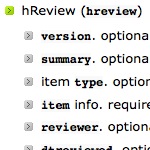Shared Annotations and Comments
[fusion_builder_container hundred_percent=”yes” overflow=”visible”][fusion_builder_row][fusion_builder_column type=”1_1″ background_position=”left top” background_color=”” border_size=”” border_color=”” border_style=”solid” spacing=”yes” background_image=”” background_repeat=”no-repeat” padding=”” margin_top=”0px” margin_bottom=”0px” class=”” id=”” animation_type=”” animation_speed=”0.3″ animation_direction=”left” hide_on_mobile=”no” center_content=”no” min_height=”none”]
When folks develop collections of resources and/or want to promote collaboration and community around educational resources, there are a number of typical features that get discussed: metadata (there I said it), search and discovery, annotations/comments/ratings, and so on. In this post I’ll talk a little bit about annotations/comments/ratings.
I’ve built and designed educational digital libraries and stand-alone systems that enable users to rate, make comments and otherwise annotate a resource. So have a lot of people. When looking at “interoperability” of collections of resources, folks usually focus first on search and discovery of the resource–this is true of the OpenCourseWare Consortium. After addressing that, then they start to think about the next level–the context of the resource such as the annotations/comments/ratings.
A bit of motivation… At April’s OpenCourseWare Consortium Meeting, Clay Whipkey asked the question (and I’m paraphrasing)…
Is there a standard for sharing annotations and comments?
–Clay Whipkey, Technical Director, OCWC
Ok, that’s as good a place as any to start. So, is there a standard?
Turns out there is, it’s a microformat type called hReview. hReview describes itself as:
Numerous web sites publish reviews using a broad variety of schema for all sorts of things from products (movies, music, books), to businesses (restaurants, hotels, stores), to events (concerts, theatre), to people (artists, leaders, celebrities), to places (landmarks, parks), to online resources (web pages, files), to reviews of reviews themselves.
In order to enable and encourage the sharing, distribution, syndication, and aggregation, of reviews, the authors propose the hReview microformat, an open standard for distributed reviews.
Source: hReview. (2009). hReview 0.3. Retrieved June 4, 2009 from Web site:http://microformats.org/wiki/hreview
The hReview site displays a number of examples and draft schemas for describing reviews. Here a review includes the typical elements that go into annotations/comments/ratings, including: reviewer, item reviewed, subject, description, normalized numerical rating, and so on.
What makes hReview (and microformats in general) really interesting is that they’re designed to be machine-readable. Recently, I read a post by Tim O’Reilly on O’Reilly’s Radar an article describing how Google was implementing display of microformats, including hReview, in its search results, something it’s calling Rich Snippets.
Tim says:
Google will take this data [/fusion_builder_column][fusion_builder_column type=”1_1″ background_position=”left top” background_color=”” border_size=”” border_color=”” border_style=”solid” spacing=”yes” background_image=”” background_repeat=”no-repeat” padding=”” margin_top=”0px” margin_bottom=”0px” class=”” id=”” animation_type=”” animation_speed=”0.3″ animation_direction=”left” hide_on_mobile=”no” center_content=”no” min_height=”none”][microformat] into account, and will provide enhanced snippets in the search results. Supported microformats in the first release include those for people and for reviews.
Source: O’Reilly, T. (2009). Google’s Rich Snippets and the Semantic Web. Retrieved June 4, 2009 from O’Reilly’s Radara Web site: http://radar.oreilly.com/2009/05/google-rich-snippets-semantic-web.html
And why does this matter?
Google has the market power to actually get people to pay attention.
Source: O’Reilly, T. (2009). Google’s Rich Snippets and the Semantic Web. Retrieved June 4, 2009 from O’Reilly’s Radara Web site: http://radar.oreilly.com/2009/05/google-rich-snippets-semantic-web.html
So this is interesting. Unfortunately it’s not universally available…yet…
If I mark up my pages, does that guarantee I’ll get Rich Snippets?
No. We will be rolling this out gradually, and as always we will use our own algorithms and policies to determine relevant snippets for users’ queries. We will use structured data when we are able to determine that it helps users find answers sooner. And because you’re providing the data on your pages, you should anticipate that other websites and other tools (browsers, phones) might use this data as well. You can let us know that you’re interested in participating by filling out this form.
Google. (2009, May 12). Introducing Rich Snippets. Retrieved June 4, 2009 from Google Webmaster Blog Web site: http://googlewebmastercentral.blogspot.com/2009/05/introducing-rich-snippets.html
[/fusion_builder_column][/fusion_builder_row][/fusion_builder_container]



